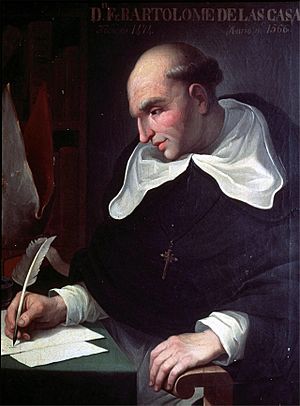Bartolomé de Las Casas facts for kids
Bartolomé de Las Casas (born 1484, died 1566) was a Spanish priest and writer from the 1500s. He is known as the Apostle of the Indies. This means he was a strong supporter and defender of the native people in the Americas. He was also the first Bishop of Chiapas, a region in Mexico.
Las Casas was a Dominican priest. He spoke out against how the Spanish empire treated the native people. His famous book, History of the Indies, helped create the idea of the "Black Legend." This idea described the Spanish as being very cruel to the people they conquered.
Contents
Who Was Bartolomé de Las Casas?
Bartolomé de Las Casas was born in Seville, Spain, in 1484. He was in Seville when Christopher Columbus returned in 1493 after his first trip to the Americas. Bartolomé's father, Pedro de las Casas, and his uncle went to the Americas with Columbus on his second voyage in November 1493.
In 1502, Bartolomé went to the Caribbean island of Hispaniola. He traveled with Nicolás de Ovando, who was the new governor of the island. In 1506, he went to Rome, Italy, where he became a Catholic priest.
His Time in the Americas
Las Casas returned to Hispaniola in 1508. He moved to a place called Concepción de la Vega. There, he received an encomienda. An encomienda was a grant of land that also included the native people living on it.
Later, in 1513, he went to Cuba. The governor, Diego Velázquez de Cuéllar, gave him another encomienda. However, Las Casas soon realized that the native people, like the Taínos, were treated very badly. They were forced to work like slaves.
Because of this, he began to defend the native people. In 1512, Las Casas became the first official priest in the New World.
Defending Native People
In 1515, Las Casas traveled from Hispaniola to Spain. His goal was to speak up for the native people of the Americas. From 1517 to 1523, he held the title Protector of the Indians.
He tried to create a special settlement in northern Venezuela. This settlement was meant to protect the native people. However, this experiment did not succeed. After this, he went back to Hispaniola. In 1523, he joined the Dominican Order, which is a group of Catholic priests.
He stayed in the city of Santo Domingo until 1527. Then, he was sent to Puerto Plata on the northern coast. There, he started a new religious community. It was also where he began writing his important book, History of the Indies.
Later Life and Famous Works
Las Casas became the Bishop of Chiapas, Mexico, from 1544 to 1547. During this time, he wrote a book about the abuse of native people. It was called A short account of the destruction of the Indies.
He finished this book in 1542, but it was not published until 1552. This book is his most famous work. After his time as bishop, he returned to Spain. He lived there until he died on July 17, 1566, in Madrid.
What Did He Write?
Here are some of his most important written works:
- Historia de las Indias ("History of the Indies")
- De Unico Vocationis Modo Omnium Infidelium ad Veram Religionem (known in Spanish as Del único modo de atraer a todos los pueblos a la verdadera religión), 1530
- Brevísima relación de la destrucción de las Indias ("A Brief Account of the Destruction of the Indies"), 1552
- Apologética historia sumaria ("Apologetic History")
- De thesauris
You can read A Brief Account of the Destruction of the Indies online at Project Gutenberg.
Images for kids
-
A contemporary painting of King Ferdinand "The Catholic"
-
View over the landscape of Mochima National Park in Venezuela, close to the original location of Las Casas's colony at Cumaná
-
Toribio de Benavente "Motolinia", Las Casas's Franciscan adversary.
-
Juan Ginés de Sepúlveda, Las Casas's opponent in the Valladolid debate
-
Monument to Bartolomé de las Casas in Seville, Spain.
See also
 In Spanish: Bartolomé de las Casas para niños
In Spanish: Bartolomé de las Casas para niños

















